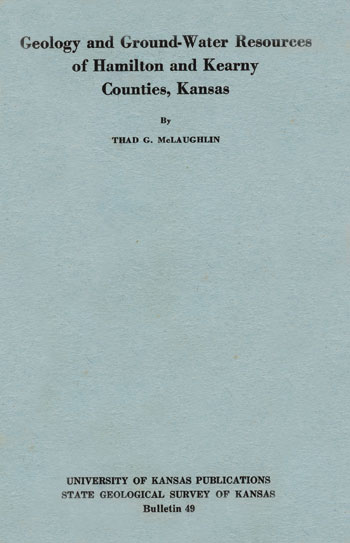Geology and Ground-water Resources of Hamilton and Kearny Counties, Kansas
By Thad G. McLaughlin with analyses by E. O. Holmes

Originally published in 1943 as Kansas Geological Survey Bulletin 49. This is, in general, the original text as published in 1943. The information has not been updated.
You may also wish to visit our web sites on the Hamilton and Kearny county geologic maps.
Abstract
This report describes the geography, geology, and ground-water resources of Hamilton and Kearny counties in southwestern Kansas. The area embraces a total of 51.5 townships, or 1,856 square miles, and had a population of 5,170 in 1940. It is relatively flat and is drained by Arkansas river and its tributaries. The climate is semiarid, the average annual precipitation being about 17 inches. Wheat farming, some cattle raising, and general farming are the principal occupations in the area.
The report contains a map of the area showing by means of shading the depth to water level. The water table ranges in depth from than 10 feet in parts of the Arkansas valley to more than 200 feet in parts of the upland north of Arkansas river. The report also contains a map of the area showing by means of contours the shape and slope of the water table. The water table slopes east-southeastward. The steepest slopes of the water table are in the upland north of Arkansas river and the most gentle slopes are in the sand hills in southern Kearny County. Arkansas river has cut its valley below the general level of the water table in adjacent upland areas with the result that some ground water moves toward the stream along a part of its course.
Flowing wells are obtained in a small area in the Arkansas valley near Coolidge. The flows range from less than one gallon to more than 25 gallons a minute. The artesian heads were found to range from less than 1 foot to about 10 feet above land surface.
The ground-water reservoir is recharged principally by precipitation that falls within the area, by the addition of water from Arkansas river in the eastern part of the area, and by underflow from adjacent areas. Water is discharged from the ground-water reservoir mainly by underflow eastward and southward into adjacent areas, by transpiration and evaporation in areas of shallow water table, and by wells. All of the domestic, stock, and public water supplies and a part of the irrigation water supplies are obtained from wells.
Most of the wells in the area are drilled, but some are dug, driven, or bored. The water is used principally for irrigation, but much is used for domestic, stock, public, and railroad supplies. Of the 96 irrigation plants visited, 85 were in use in 1939. They supplied about 23,600 acre-feet of water to irrigate approximately 12,650 acres (including 2,000 acres in Finney County; includes also land irrigated by surface water and by a supplementary supply of ground water). Most of these wells are in the Arkansas valley, but a few are in the upland north of Deerfield. It is believed that additional irrigation supplies could be developed in the shallow-water area north of Deerfield, in parts of the Arkansas valley, and in southwestern Hamilton County.
The report includes a discussion of the fluctuations of water levels in wells as determined by periodic measurement of water levels in representative wells. Water levels in this area were relatively low in 1939, but the water levels in most wells rose in 1940, 1941, and 1942 as a result of above-normal precipitation.
The ground water in this area is hard but it is suitable for most ordinary uses. The waters from the Cheyenne sandstone, the Dakota formation, and the undifferentiated Pliocene and Pleistocene deposits are similar in composition and hardness. Waters from the alluvium generally are very hard.
The report also contains a map showing the rock formations that crop out in this area. The rocks discussed in this report range in age from Permian to Recent, but rocks older than the Dakota formation do not crop out in this area. The principal water-bearing formations are the alluvium, the undifferentiated Pliocene (Ogallala formation) and Pleistocene deposits, the Dakota formation, and the Cheyenne sandstone.
The field data upon which most of this report is based are given in tables, and include records of 361 wells and chemical analyses of the water from 50 representative wells. Logs of 70 test holes, water wells, and oil and gas wells in the area are given, including 27 test holes put down by the State and Federal Geological Surveys.
Kansas Geological Survey, Geology
Placed on web Oct. 25, 2007; originally published December 1943.
Comments to webadmin@kgs.ku.edu
The URL for this page is http://www.kgs.ku.edu/General/Geology/Hamilton/index.html